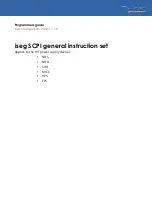
1.3.2 Channel operation modes
Operation Mode
Description
Off
The channel is off, it does not generate high voltage. If all status conditions are satisfied, the channel can
be turned on.
On
The channel is actively generating high voltage.
Ramping
The channel ramps to the voltage set V
set
if turned on or is turns off with the programmed ramp speed.
NHR and SHR devices provide voltage and current ramp speed setting per channel in V/s resp. A/s.
All other devices have a common voltage and current ramp speed for all channels in %/s.
A ramp speed of 1 V/s means, the voltage changes with 1 Volt every second until it reaches the
destination. A ramp speed of 1 %/s means, that for a voltage nominal of 1000 V, the voltage changes with
10 Volt every second until it reaches the destination. (1000 V • 1 %/s = 10 V/s)
Emergency Off
The channel is shut down without ramp. Afterwards, it stays in Emergency Off until Emergency Clear is
given.
Emergency Clear
The channel leaves the state Emergency Off and goes to state Off. If the channel is not in Emergency Off,
nothing happens.
Kill Enable
The mode Kill Enable provides a higher safety. This mode is module-wide and therefore affects all
channels. The channel will go to Trip and shut down without ramp when any of the following conditions
occur:
•
V
meas
> V
lim
•
I
meas
> I
lim
•
I
meas
>
I
set
OR
OR
OR
•
V
meas
> V
set
+ V
bounds
•
V
meas
< V
set
- V
bounds
•
I
meas
< I
set
- I
bounds
Constant Voltage
The channel operates as constant voltage source, that means V
meas
≈ V
set
and I
meas
< I
set
Constant Current
The channel operates as constant current source, that means V
meas
< V
set
and I
meas
≈ I
set
Delayed Trip
This is a special mode of Constant Current. If this mode is activated, and I
meas
reaches or exceeds I
set
, the
Channel Status Is Current Trip is generated. Depending on the trip configuration, the channel may stay in
Constant Current, or turn off with ramp or shut down without ramp.
Trip also happens when Kill Enable is active and any of the Kill conditions occur.
External Inhibit
External Inhibit is a hardware line to control the high voltage generation.
Depending on the device, there might be one External Inhibit per channel or one External Inhibit for all
channels.
Some devices always shut down the high voltage without ramp on External Inhibit, some devices allow to
configure this function, as shown below.
External Inhibit individual per channel
NHS, NHR, SHR
External Inhibit for all channels
MICC, HPS, FPS
External Inhibit Action is configurable
NHS, NHR, SHR
External Inhibit shuts down channel without ramp
MICC, HPS, FPS
Input Error
An input error occurs, if an invalid command or parameter is given, or the parameter of a command
exceeds the allowed range. Example: setting a V
set
of 4000 V for a channel with V
nom
of 3000 V.
Fine Adjustment
The fine adjustment allows a long-term stabilization of the output voltage. Since the DAC typically drifts
more with temperature changes, it is readjusted based on the ADC measurement values.
ADC Sample Rate
The ADC sample rate determines the resolution and noise of the measurement. Lower sample rates
typically lead to better results but slower updating.
SCPI protocol common instruction set | Last changed on: 2020-11-10 |
www.iseg-hv.com
10/63











































